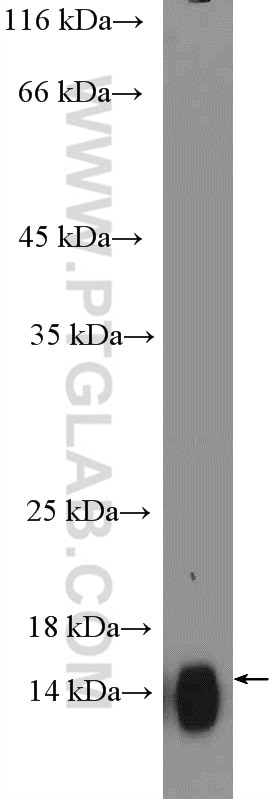Tested Applications
| Positive WB detected in | human saliva tissue |
Recommended dilution
| Application | Dilution |
|---|---|
| Western Blot (WB) | WB : 1:500-1:1000 |
| It is recommended that this reagent should be titrated in each testing system to obtain optimal results. | |
| Sample-dependent, Check data in validation data gallery. | |
Published Applications
| KD/KO | See 1 publications below |
| WB | See 2 publications below |
| IHC | See 1 publications below |
Product Information
19935-1-AP targets CST2-Specific in WB, IHC, ELISA applications and shows reactivity with human samples.
| Tested Reactivity | human |
| Cited Reactivity | human |
| Host / Isotype | Rabbit / IgG |
| Class | Polyclonal |
| Type | Antibody |
| Immunogen |
Peptide Predict reactive species |
| Full Name | cystatin SA |
| Calculated Molecular Weight | 16 kDa |
| Observed Molecular Weight | 12-15 kDa |
| GenBank Accession Number | NM_001322 |
| Gene Symbol | CST2 |
| Gene ID (NCBI) | 1470 |
| RRID | AB_2878627 |
| Conjugate | Unconjugated |
| Form | Liquid |
| Purification Method | Antigen affinity purification |
| UNIPROT ID | P09228 |
| Storage Buffer | PBS with 0.02% sodium azide and 50% glycerol, pH 7.3. |
| Storage Conditions | Store at -20°C. Stable for one year after shipment. Aliquoting is unnecessary for -20oC storage. 20ul sizes contain 0.1% BSA. |
Background Information
CST2, also named as Cystatin-2 and Cystatin-S5, belongs to the cystatin family. CST2 is a T a secreted thiol protease inhibitor found at high levels in saliva, tears and seminal plasma. This antibody is specific to CST2.
Protocols
| Product Specific Protocols | |
|---|---|
| WB protocol for CST2-Specific antibody 19935-1-AP | Download protocol |
| Standard Protocols | |
|---|---|
| Click here to view our Standard Protocols |
Publications
| Species | Application | Title |
|---|---|---|
Cell Res Differential secretome analysis reveals CST6 as a suppressor of breast cancer bone metastasis. | ||
Cancer Cell Int Identification of novel key genes associated with the metastasis of prostate cancer based on bioinformatics prediction and validation.
|




